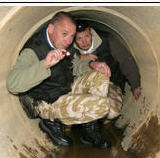Predators in a digital age: vans and candy replaced by internet and IP's
Page 1 of 1 • Share
 Predators in a digital age: vans and candy replaced by internet and IP's
Predators in a digital age: vans and candy replaced by internet and IP's
19 May 2014 - Today, the boogey-man rarely hides under the bed or in the closet, but rather you'll find him behind a computer monitor. A computer screen today is a mask hiding one’s identity, facilitating exploitation of the vulnerable.
None are more vulnerable on the web than children, and the internet allows predators to exploit children around the world, even in the safety of their own homes. The UN Office on Drugs and Crime (UNODC), in cooperation with experts in law enforcement and academia, has [You must be registered and logged in to see this link.] on the effects of new technologies on the abuse and exploitation of children.
Children have unprecedented access to computers and mobile technologies, and have in recent decades tended to adopt these from an early age, resulting in Information and Communication technologies (ICTs) becoming thoroughly embedded in their lives. But this unprecedented access is rife with dangers, especially for young users.
“Cyberspace is a place where children can be groomed with impunity, while the perpetrators remain hidden. By launching this study, UNODC and its partners are helping to bring online child abusers out of the shadows and into the judicial spotlight through better training and better investigative techniques among law enforcement officers,” said UNODC Executive Director Yury Fedotov.
One of the most recent examples are the 251 victims of an exploitation website based in the US, whose members groomed and abused children from around the world to create explicit child sexual abuse material. Children from five countries were identified by the immigration and customs enforcement arm (Ice) of the US Department of Homeland Security. The website, which ran from June 2012 to June 2013 on an encrypted web service, had about 27,000 subscribers and contained about 2,000 webcam videos of the victims at the time it was shut down, according to the department. At least one of the men created fake female personas on social media sites to lure and exploit the children. He also admitted to coaching others to do the same.
Purveyors of child pornography have found in the digital-age a simple and hard to track way of exploiting children. Cases have emerged around the world where seemingly respectable members of society around the world have used the anonymity of the computer to feed their darker impulses. This was highlighted in Greece, when a pediatrician was arrested for possession and distribution of large quantities of child pornographic materials. Or the case of a U.S. Navy pilot who used a false Facebook account to lure a 15-year-old girl into sending him explicit photos.
The globalized and anonymous cyberspace environment also help predators evade detection in new ways, and a multitude of technical challenges hinder governments' abilities to identify and address child exploitation offences. Organized criminal networks also exploit the void, profiting from the commercial child pornography and child sex trafficking markets. This market is further helped by a lack of consistent legislation as individual states vary considerably in their definitions of child abuse and exploitation, and often cannot move fast enough to enact laws that keep pace with technology.
[You must be registered and logged in to see this link.]
None are more vulnerable on the web than children, and the internet allows predators to exploit children around the world, even in the safety of their own homes. The UN Office on Drugs and Crime (UNODC), in cooperation with experts in law enforcement and academia, has [You must be registered and logged in to see this link.] on the effects of new technologies on the abuse and exploitation of children.
Children have unprecedented access to computers and mobile technologies, and have in recent decades tended to adopt these from an early age, resulting in Information and Communication technologies (ICTs) becoming thoroughly embedded in their lives. But this unprecedented access is rife with dangers, especially for young users.
“Cyberspace is a place where children can be groomed with impunity, while the perpetrators remain hidden. By launching this study, UNODC and its partners are helping to bring online child abusers out of the shadows and into the judicial spotlight through better training and better investigative techniques among law enforcement officers,” said UNODC Executive Director Yury Fedotov.
One of the most recent examples are the 251 victims of an exploitation website based in the US, whose members groomed and abused children from around the world to create explicit child sexual abuse material. Children from five countries were identified by the immigration and customs enforcement arm (Ice) of the US Department of Homeland Security. The website, which ran from June 2012 to June 2013 on an encrypted web service, had about 27,000 subscribers and contained about 2,000 webcam videos of the victims at the time it was shut down, according to the department. At least one of the men created fake female personas on social media sites to lure and exploit the children. He also admitted to coaching others to do the same.
Purveyors of child pornography have found in the digital-age a simple and hard to track way of exploiting children. Cases have emerged around the world where seemingly respectable members of society around the world have used the anonymity of the computer to feed their darker impulses. This was highlighted in Greece, when a pediatrician was arrested for possession and distribution of large quantities of child pornographic materials. Or the case of a U.S. Navy pilot who used a false Facebook account to lure a 15-year-old girl into sending him explicit photos.
The globalized and anonymous cyberspace environment also help predators evade detection in new ways, and a multitude of technical challenges hinder governments' abilities to identify and address child exploitation offences. Organized criminal networks also exploit the void, profiting from the commercial child pornography and child sex trafficking markets. This market is further helped by a lack of consistent legislation as individual states vary considerably in their definitions of child abuse and exploitation, and often cannot move fast enough to enact laws that keep pace with technology.
[You must be registered and logged in to see this link.]

Olympicana_Reloaded- Posts : 167
Activity : 203
Likes received : 0
Join date : 2012-07-10
 Similar topics
Similar topics» I Was a Paid Internet Shill: How Shadowy Groups Manipulate Internet Opinion and Debate
» INTERNET TROLLS - Maximum term to be raised from 6 months to TWO YEARS IN JAIL (and prosecutions to be able to take place up to 3 years after an internet posting)
» Jim Gamble: Vigilante Hunters aren’t the solution; Digital Detectives are
» Joana Morais
» Not all sexual predators the same, expert teaches
» INTERNET TROLLS - Maximum term to be raised from 6 months to TWO YEARS IN JAIL (and prosecutions to be able to take place up to 3 years after an internet posting)
» Jim Gamble: Vigilante Hunters aren’t the solution; Digital Detectives are
» Joana Morais
» Not all sexual predators the same, expert teaches
Page 1 of 1
Permissions in this forum:
You cannot reply to topics in this forum





































